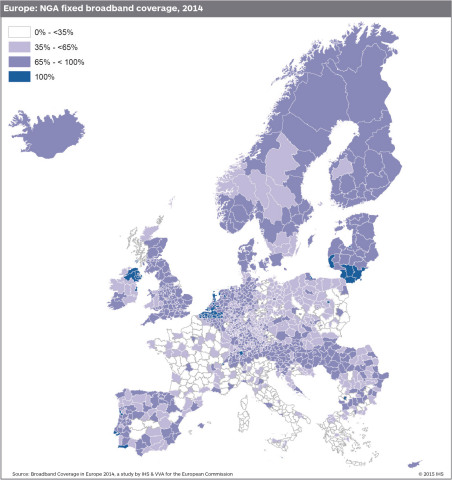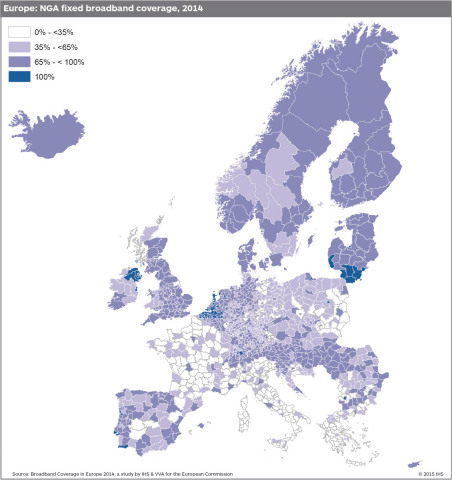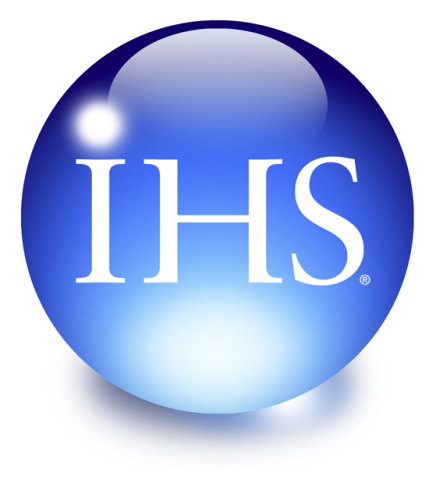LONDON--(BUSINESS WIRE)--A new study on broadband access in the European Union (EU) produced by IHS Inc. (NYSE: IHS), the leading global source of critical information and insight, and released today by the European Commission, found that between 2013 and 2014, next-generation broadband and LTE coverage made big jumps in coverage availability.
The study, Broadband Coverage in Europe 2014: Mapping Progress towards the Coverage Objectives of the Digital Agenda, was prepared for the European Commission by IHS Technology and Valdani, Vicari & Associati (VVA). To download the full report visit: https://ec.europa.eu/digital-agenda/en/news/study-broadband-coverage-europe-2014.
Europe-wide trend: LTE on the rise
Overall, three million new households gained access to broadband (both mobile and fixed broadband) in the past year, bringing the total to more than 216 million across the EU. About 15.5 million new households gained access to high-speed next-generation broadband and LTE coverage rose from 59 percent in 2013 to 79 percent in 2014.
“In the past year, we have seen LTE coverage across the EU increase at a record pace and it was the fastest growing broadband access technology in terms of coverage,” said Alzbeta Fellenbaum, senior analyst at IHS Technology. “Mobile operators have expanded their network coverage areas across the EU and additional service providers have launched new LTE offerings.”
LTE coverage recorded the highest growth of all access technologies in rural areas as well, increasing from about 15 percent in 2013 to 27 percent in 2014. “With the continued growth of LTE coverage and improvements in LTE network performance, it is possible to expect a further positive impact LTE technology will have on the expansion of rural broadband availability,” Fellenbaum said.
Europe-wide trend: Next-generation broadband
Out of the 31 study countries, 19 countries had fixed broadband coverage levels at or above the EU average of 97 percent at the end of 2014, 27 countries had fixed broadband covering at least 90 percent of their households. Fixed broadband coverage was highest in Cyprus, Luxembourg, Malta, the Netherlands and the United Kingdom and lowest in Poland, Slovakia, Estonia and Romania, where it reached between 85 percent and 89 percent of households.
Malta was the only country to report complete coverage for Next Generation Access (NGA) technologies, followed by Belgium, Switzerland, the Netherlands, Lithuania, Luxembourg and Denmark, all above 90 percent. In total, 24 countries performed above the European average (68 percent) with regards to NGA availability, and only three countries reported NGA coverage below 50 percent (France, Greece and Italy).
UK
The United Kingdom is one of the top performers with regards to overall broadband coverage and fixed broadband coverage, reporting complete coverage on national level and nearly complete coverage in rural areas. National NGA coverage was the fastest growing category in the UK, increasing coverage by 6.8 percentage points to 89 percent of all households; over twenty percentage points above the EU average.
France
By the end of 2014, overall and fixed broadband coverage in France remained above the EU average, both on national and rural level. NGA coverage, however, remained below the European average despite being the category that grew the most between 2013 and 2014. In 2014, high-speed broadband services were available to 42.6 percent of all French households and 20 percent of rural households.
Italy
In 2014, overall broadband coverage and fixed broadband coverage in Italy exceeded the EU average. Despite NGA coverage increasing by 15.5 percentage points throughout the year and reaching 36 percent of Italian households, it remained below the EU average. In rural areas, progress was made with regard to fixed broadband coverage, which increased by 2.8 percentage points to 90.5 percent, almost one percentage point above the EU average of 90 percent. However, Italy was the only country with no rural NGA coverage in 2014.
Germany
In 2014, Germany remained above average in all technology combinations, with the slight exception of overall rural coverage. Most substantial gains in coverage were recorded for NGA technologies, with national coverage reaching 81 percent of households (a six percentage point increase compared to 2013) and rural NGA coverage passing a third of rural households in Germany, a significant 12 percentage point growth year-on-year. These increases in turn contributed to Germany outperforming the average by almost 13 percentage points for national NGA coverage and eight percentage points in the case of rural NGA coverage.
About IHS (www.ihs.com)
IHS (NYSE: IHS) is the leading source of insight, analytics and expertise in critical areas that shape today’s business landscape. Businesses and governments in more than 150 countries around the globe rely on the comprehensive content, expert independent analysis and flexible delivery methods of IHS to make high-impact decisions and develop strategies with speed and confidence. IHS has been in business since 1959 and became a publicly traded company on the New York Stock Exchange in 2005. Headquartered in Englewood, Colorado, USA, IHS is committed to sustainable, profitable growth and employs about 8,800 people in 32 countries around the world.
IHS is a registered trademark of IHS Inc. All other company and product names may be trademarks of their respective owners. © 2015 IHS Inc. All rights reserved.




